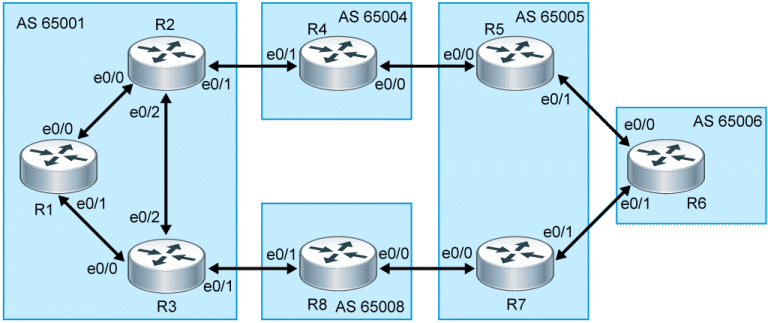BGP – Configuring BGP on Cisco Routers

The BGP Configuring BGP on Cisco Routers Course provides the participant with an in-depth knowledge of the Border Gateway Protocol. This technology undoubtedly represents a fundamental pillar of the Internet. The course program covers the theory of BGP and its implementation on Cisco devices. Starting initially from basic concepts, it continues towards the treatment of advanced features such as route reflectors, route selection, routing registries, policy, filtering, bogon filtering etc. The part of the course regarding BGP troubleshooting is addressed through a series of practical exercises that the student can carry out with the supervision of the teacher on real Cisco devices.
Course Objectives
Below is a summary of the main objectives of the BGP Configuring BGP on Cisco Routers Course :
- Gain a thorough understanding of the Border Gateway Protocol.
- Understand BGP theory and its implementation on Cisco devices.
- Get familiar with advanced features like route reflectors and route selection.
- Learn BGP troubleshooting techniques through hands-on exercises.
- Implement and manage BGP in real networks using Cisco devices.
- Gain practical experience with network automation and orchestration tools.
- Learn how to implement intent-based policies and optimize network performance.
- Understand the role of machine learning and artificial intelligence in enhancing IBN operations.
Course Certification
This course helps you prepare to take the:
Cisco Enterprise Certifications.
Course Outline
- BGP Overview
- Introducing BGP
- Understanding BGP Path Attributes
- Establishing BGP Sessions
- Processing BGP Routes
- Configuring Basic BGP
- Monitoring and Troubleshooting BGP
- Module Summary
- Self-Check Module
- BGP Transit Autonomous Systems
- Working with Transit AS
- Interacting with IBGP and EBGP in Transit AS
- Forwarding Packets in Transit AS
- Monitoring and Troubleshooting IBGP in Transit AS
- Module Summary
- Self-Check Module
- Route Selection Using Policy Controls
- Using Multihomed BGP Networks
- Employment AS Path Filters
- Filtering with Prefix Lists
- Using Outbound Route Filtering
- Applying Route Maps as BGP Filters
- Implementing Changes in BGP Policy
- Module Summary
- Self-Check Module
- Route Selection Using Attributes
- Influencing BGP Route Selection with Weights
- Setting BGP Local Preference
- Using AS Path Prepending
- Understanding BGP Multi-Exit Discriminators
- Addressing BGP Communities
- Module Summary
- Self-Check Module
- Customer-to-Provider Connectivity with BGP
- Understanding Customer-to-Provider Connectivity Requirements
- Implementing Customer Connectivity Using Static Routing
- Connecting a Customer to a Single Service Provider
- Connecting a Multihomed Customer to Multiple Service Providers
- Module Summary
- Self-Check Module
- Scaling Service Provider Networks
- Scaling IGP and BGP in Service Provider Networks
- Introducing and Designing Route Reflectors
- Configuring and Monitoring Route Reflectors
- Module Summary
- Self-Check Module
- Optimizing BGP Scalability
- Improving BGP Convergence
- Limiting the Number of Prefixes Received from a BGP Neighbor
- Implementing BGP Peer Groups
- Using BGP Route Dampening
- Module Summary
- Self-Check Module
Laboratory Activities
- Configure Basic BGP
- Announcing Networks in BGP
- Implement BGP TTL Security Check
- BGP Route Propagation
- IBGP Full Mesh
- BGP Administrative Distance
- Configure Non-Transit Autonomous System
- Filtering Customer Prefixes
- Prefix-Based Outbound Route Filtering
- Configure Route Maps as BGP Filters
- Configure Per-Neighbor Weights
- Configure and Monitor Local Preference
- Configure Local Preference Using Route Maps
- Configure AS Path Prepending
- Configure MED
- Configure Local Preference Using the Communities
- Configure Route Reflector
- Configure BGP Route Limitation
- Configure BGP Peer Groups
- Configure BGP Route Dampening
- Configure a Basic BGP Network
- Configure a BGP Transit AS
- Configure BGP Using BGP Filtering
- Configure BGP Route Selection Using BGP Attributes
- Configure BGP Route Reflectors
Course Mode
Instructor-Led Remote Live Classroom Training;
Trainers
Trainers are Cisco Official Instructors and certified in other IT technologies, with years of hands-on experience in the industry and in Training.
Lab Topology
For all types of delivery, the Trainee can access real Cisco equipment and systems in our laboratories or directly at the Cisco data centers remotely 24 hours a day. Each participant has access to implement the various configurations thus having a practical and immediate feedback of the theoretical concepts.
Here are some Cisco Labs network topologies available:

Course Details
Course Prerequisites
- Attendance at the Cisco CCNA Course is recommended .
Course Duration
Intensive duration 5 days
Course Frequency
Course Duration: 5 days (9.00 to 17.00) - Ask for other types of attendance.
Course Date
- Cisco BGP Course(Intensive Formula) – On request – 9:00 – 17:00
Steps to Enroll
Registration takes place by asking to be contacted from the following link, or by contacting the office at the international number +355 45 301 313 or by sending a request to the email info@hadartraining.com


